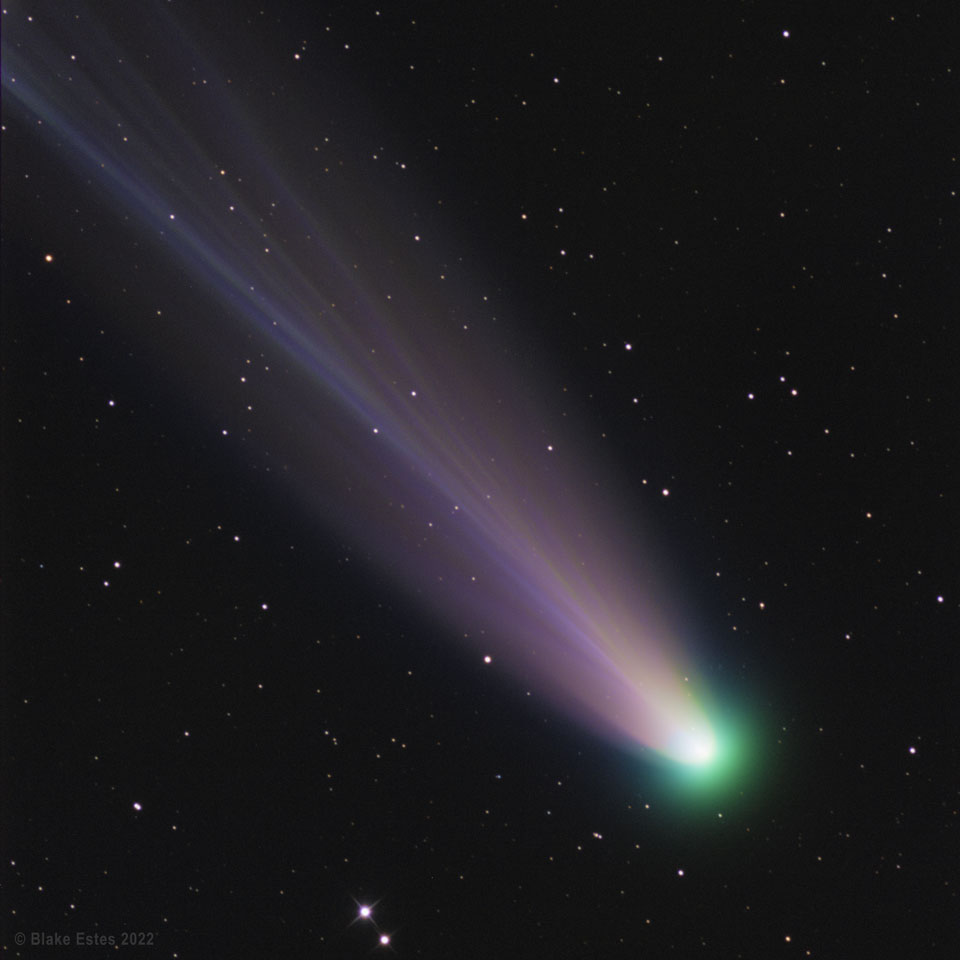12. January 2022
Ùi 澳洲 看 Leonard 彗星 ê 特寫

探索宇宙1!逐工會揀一幅無仝款 ê 影像抑是相片,𤆬你熟似咱這个迷人 ê 宇宙,閣有專業天文學者2為你解說3。
- 原始文章:Comet Leonard Closeup from Australia
- 影像來源 kah 版權:Blake Estes (itelescope.net)
- 台文翻譯:An-Li Tsai (NCU)
[漢羅] Ùi 澳洲 看 Leonard 彗星 ê 特寫
彗星若是倚近 kā 看,會是啥物模樣? 雖罔講咱無法度真正到彗星遐,毋閣咱會使用細台望遠鏡翕彗鬚 kah 彗尾內部,按呢可能會當予咱一寡想法。 會叫做 離子尾溜 這个名,就表示講伊 ê 組成成份是 離子氣體。 這寡氣體是去予太陽發出 ê 紫外光 激發,才閣去予 太陽風 歕出來 ê。 太陽風是有結構 ê。是去予太陽複雜 多變 ê 磁場 雕出來 ê。 多變 ê 太陽風 kah 各種 ùi 彗核 kiat–出來 ê 氣體噴流 相濫 ê 影響,產生彗尾 ê 複雜結構。 綴太陽風 ê 方向來看,Leonard 彗星 尾溜 ê 結構是離開太陽 ê 方向,伊 ê 形體 嘛綴時間變來變去。 藍色 ê 離子尾溜主要是 ùi 重組 ê 一氧化碳 分子來 ê。 彗星頭 邊仔 青色 ê 彗鬚主要是 ùi 少量 重組 ê 雙原子碳 分子來 ê。 雙原子碳會 tī 50 點鐘 ê 時間內底去予太陽光破壞去,這就是 是按怎伊 ê 青光 袂走到離子彗尾遐。 這張相片是 1 月 2 號 tī 澳洲 Siding Spring 天文台 翕 ê。 Leonard 彗星 上媠 ê 模樣愛 ùi 地球 ê 南半球來 kā 看。 伊這馬已經 踅過太陽,欲離開 太陽系 矣。
[POJ] Ùi Ò-chiu khòaⁿ Leonard hui-chhiⁿ ê te̍k-siá
Hui-chhiⁿ nā-sī óa-kīn kā khòaⁿ, ē sī siáⁿ-mí bô͘-iūⁿ? Sui-bóng kóng lán bô-hoat-tō͘ chin-chiàⁿ kàu hui-chhiⁿ hiah, m̄-koh lán ē-sái iōng sè-tâi bōng-oán-kiàⁿ hip hūi-chhiu kah hūi-bóe lōe-pō͘, án-ne khó-lêng ē-tàng hō͘ lán chi̍t-kóa siūⁿ-hoat. Ē kiò-chò lî-chú bóe-liu chi̍t-ê-miâ, to̍h piáu-sī kóng i ê cho͘-sêng sêng-hūn sī lî-chú khì-thé. Chit-kóa khì-thé sī khì hō͘ thài-iông hoat–chhut ê chí-gōa-kng kek-hoat, chiah koh khì hō͘ thài-iông-hong pûn–chhut-lâi ê. Thài-iông-hong sī ū kiat-kò͘ ê. Sī khì hō͘ Thài-iông ho̍k-cha̍p to-piàn ê chû-tiûⁿ tiau–chhut-lâi ê. To-piàn ê thài-iông-hong kah kok-chióng ùi hūi-he̍k kiat–chhut-lâi ê khì-thé phùn-liû sio-lām ê éng-hióng, sán-seng hūi-bóe ê ho̍k-cha̍p kiat-kò͘. Tòe thài-iông-hong ê hong-hiòng lâi khòaⁿ, Leonard hui-chhiⁿ bóe-liu ê kiat-kò͘ sī lī-khui thài-iông ê hong-hiòng, i ê hêng-thé mā tòe sî-kan piàn-lâi-piàn-khì. Nâ-sek ê lî-chú bóe-liu chú-iàu sī ùi têng-cho͘ ê it-ióng-hòa-thòaⁿ hun-chú lâi ê. Hui-chhiⁿ-thâu piⁿ-á chhiⁿ-sek ê hūi-chhiu chú-iàu sī ùi chió-liōng têng-cho͘ ê siang-goân-chú-thòaⁿ hun-chú lâi ê. Siang-goân-chú-thòaⁿ ē tī gō͘-cha̍p tiám-cheng ê sî-kan lāi-té khì hō͘ thài-iông-kng phò-hoāi–khì, che tō-sī sī-án-chóaⁿ i ê chhiⁿ-kng bōe cháu kàu lî-chú hūi-bóe hiah. Chit-tiuⁿ siòng-phìⁿ sī it goe̍h jī hō tī Ò-chiu Siding Spring Thian-bûn-tâi hip ê. Leonard hui-chhiⁿ siōng súi ê bô͘-iūⁿ ài ùi Tē-kiû ê lâm-pòaⁿ-kiû lâi kā khòaⁿ. I chit-má í-keng se̍h kòe thài-iông, beh lī-khui Thài-iông-hē ah.
[KIP] Uì Ò-tsiu khuànn Leonard hui-tshinn ê ti̍k-siá
Hui-tshinn nā-sī uá-kīn kā khuànn, ē sī siánn-mí bôo-iūnn? Sui-bóng kóng lán bô-huat-tōo tsin-tsiànn kàu hui-tshinn hiah, m̄-koh lán ē-sái iōng sè-tâi bōng-uán-kiànn hip huī-tshiu kah huī-bué luē-pōo, án-ne khó-lîng ē-tàng hōo lán tsi̍t-kuá siūnn-huat. Ē kiò-tsò lî-tsú bué-liu tsi̍t-ê-miâ, to̍h piáu-sī kóng i ê tsoo-sîng sîng-hūn sī lî-tsú khì-thé. Tsit-kuá khì-thé sī khì hōo thài-iông huat–tshut ê tsí-guā-kng kik-huat, tsiah koh khì hōo thài-iông-hong pûn–tshut-lâi ê. Thài-iông-hong sī ū kiat-kòo ê. Sī khì hōo Thài-iông ho̍k-tsa̍p to-piàn ê tsû-tiûnn tiau–tshut-lâi ê. To-piàn ê thài-iông-hong kah kok-tsióng uì huī-hi̍k kiat–tshut-lâi ê khì-thé phùn-liû sio-lām ê íng-hióng, sán-sing huī-bué ê ho̍k-tsa̍p kiat-kòo. Tuè thài-iông-hong ê hong-hiòng lâi khuànn, Leonard hui-tshinn bué-liu ê kiat-kòo sī lī-khui thài-iông ê hong-hiòng, i ê hîng-thé mā tuè sî-kan piàn-lâi-piàn-khì. Nâ-sik ê lî-tsú bué-liu tsú-iàu sī uì tîng-tsoo ê it-ióng-huà-thuànn hun-tsú lâi ê. Hui-tshinn-thâu pinn-á tshinn-sik ê huī-tshiu tsú-iàu sī uì tsió-liōng tîng-tsoo ê siang-guân-tsú-thuànn hun-tsú lâi ê. Siang-guân-tsú-thuànn ē tī gōo-tsa̍p tiám-tsing ê sî-kan lāi-té khì hōo thài-iông-kng phò-huāi–khì, tse tō-sī sī-án-tsuánn i ê tshinn-kng buē tsáu kàu lî-tsú huī-bué hiah. Tsit-tiunn siòng-phìnn sī it gue̍h jī hō tī Ò-tsiu Siding Spring Thian-bûn-tâi hip ê. Leonard hui-tshinn siōng suí ê bôo-iūnn ài uì Tē-kiû ê lâm-puànn-kiû lâi kā khuànn. I tsit-má í-king se̍h kuè thài-iông, beh lī-khui Thài-iông-hē ah.
[English] Comet Leonard Closeup from Australia
What does Comet Leonard look like up close? Although we can’t go there, imaging the comet’s coma and inner tails through a small telescope gives us a good idea. As the name implies, the ion tail is made of ionized gas – gas energized by ultraviolet light from the Sun and pushed outward by the solar wind. The solar wind is quite structured and sculpted by the Sun’s complex and ever changing magnetic field. The effect of the variable solar wind combined with different gas jets venting from the comet’s nucleus accounts for the tail’s complex structure. Following the wind, structure in Comet Leonard’s tail can be seen to move outward from the Sun even alter its wavy appearance over time. The blue color of the ion tail is dominated by recombining carbon monoxide molecules, while the green color of the coma surrounding the head of the comet is created mostly by a slight amount of recombining diatomic carbon molecules. Diatomic carbon is destroyed by sunlight in about 50 hours – which is why its green glow does not make it far into the ion tail. The featured imagae was taken on January 2 from Siding Spring Observatory in Australia. Comet Leonard, presently best viewed from Earth’s Southern Hemisphere, has rounded the Sun and is now headed out of the Solar System.
詞彙學習(漢羅/POJ/KIP/華語/English)
- 【太陽風】thài-iông-hong/thài-iông-hong/太陽風/solar wind
- 【彗鬚】hūi-chhiu/huī-tshiu/彗髮/comet’s coma
- 【彗尾】hūi-bóe/huī-bué/彗尾/comet’s tail
- 【彗核】hūi-he̍k/huī-hi̍k/彗核/comet’s nucleus
- 【一氧化碳】it-ióng-hòa-thòaⁿ/it-ióng-huà-thuànn/一氧化碳/carbon monoxide
- 【雙原子碳】siang-goân-chú-thòaⁿ/siang-guân-tsú-thuànn/雙原子碳/diatomic carbon
- 【重組】têng-cho͘/tîng-tsoo/重組/recombining